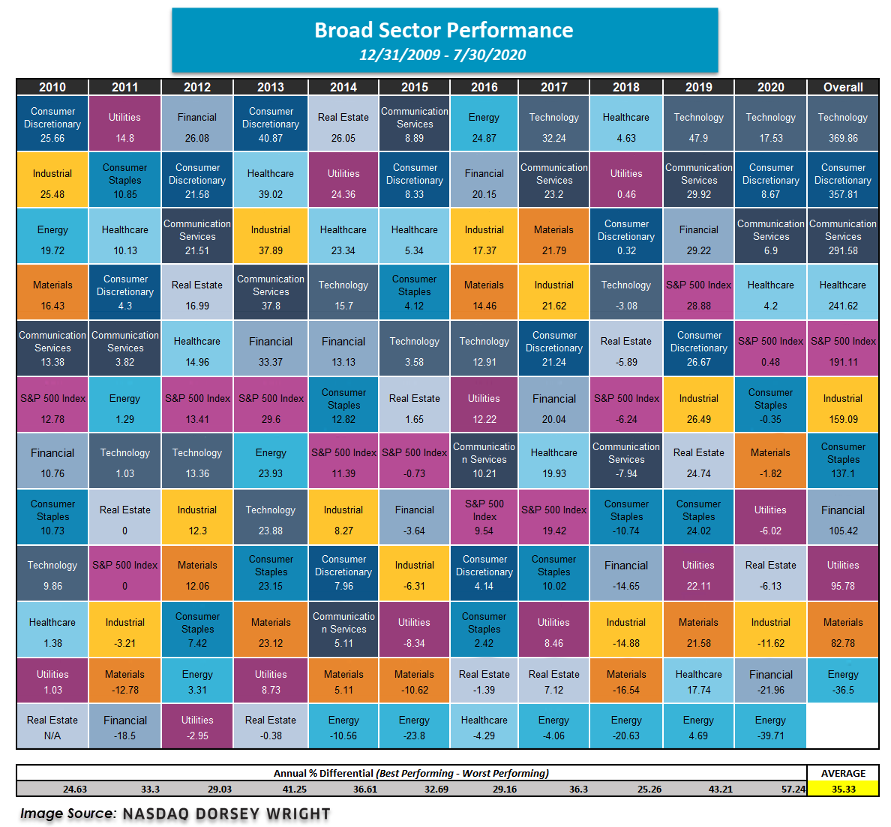The stock market and the economy feel bifurcated. In an effort to walk with you through this situation, I have been sharing data that supports that the glass may be half full, not half empty like many seem to think.
This blog is the final part of a trilogy that discusses data on the current context of the market. The three points I discuss are, in order, as follows:
To recap, investor sentiment is a contrary indicator. The lower it goes, the more pent-up demand is created. Current investor sentiment matches the lows in May before the equity rally in June. Prior to this time, the indicator had not seen levels this low since February 2016. But today’s stock market is enjoying a “superfecta” of positive forces: widespread investor fears, an unprecedented policy push, a significant economic bounce from the “lockdown recession,” and an economy with limited room for improvement (starting with a double-digit unemployment rate).
My final point is that dispersion separates the current winners and losers of the subsectors in the S&P 500 — and the distance is growing wider. As a result, it may be more important than ever to concentrate your exposure, not diversify your portfolio performance into mediocrity.
Performance dispersion is a key driver behind the success of sector rotation strategies. As an executive, you know how to make data-dependent decisions. Consider this data on sector rotation strategies, courtesy of Nasdaq Dorsey Wright.
Blog: Source: Dorsey Wright
Relative Strength methodologies are objective and adaptable. They allow us to navigate market cycles by identifying leadership trends. Knowing when to own specific sectors and when not to hold them is of the utmost importance. A key driver of the success of sector rotation strategies is the performance dispersion that occurs between those sectors. In the image below, we show the broad sector performance quilt updated to highlight the performance dispersion between the ten broad US sectors since the beginning of 2010. This dispersion acts as the “fuel” for sector rotation strategies, as adaptive portfolios have the potential to capture more of the returns from more robust sectors while limiting exposure to weaker areas, producing added returns over time. The wider the dispersion is between the best and worst-performing sectors, the more potential we see.




Introducing smaller market categories through sub-sectors or individual stock selection adds to that “fuel” by widening the dispersion. To illustrate, we have taken the 40 sectors and the ten S&P broad groups and shown their respective dispersions each year since the beginning of 2010. On average, the annual dispersion of the broad groups has been 35.33%. When we look at the average yearly dispersion for the 40 sectors, we see that value increases to 77.07%. Expanding the inventory is like casting a wider net to increase the potential for upside opportunity.




While I don’t know if our solutions would be a fit in your unique situation, I’ve got some ideas and best practices I’ve seen work well for executives like you. If you’re interested in learning more about them, let’s set up a brief, introductory call so I can learn about you to see whether it makes sense to schedule a demo. Click here to learn more about Nasdaq Dorsey Wright.
Keep in mind that individuals cannot invest directly in any index, and index performance does not include transaction costs or other fees, which will affect actual investment performance. Individual investor’s results will vary. Past performance does not guarantee future results.
The attached research DJIA research report was prepared and published by a third party and is being provided to you by Raymond James Financial Services, Inc. solely for informative purposes. Any person receiving this report from Raymond James Financial Services, Inc. and/or its affiliates should direct all questions and requests for additional information to their financial advisors and may not contact any analyst or representative of the third-party research provider. Neither Raymond James Financial Services, Inc. nor any third-party research provider is responsible for any action or inaction you may take as a result of reviewing this report or for the consequences of said action or inaction.
Any information is not a complete summary or statement of all available data necessary for making an investment decision and does not constitute a recommendation. Past performance is not a guarantee of future results. Investing involves risk regardless of the strategy selected. Opinions expressed are those of the author and not necessarily those of Raymond James. There is no guarantee that these statements, opinions or forecasts provided herein will prove to be correct.
The Dow Jones Industrial Average (DJIA), commonly known as “The Dow,” is an index representing the stocks of 30 companies maintained and reviewed by the editors of the Wall Street Journal.
The S&P 500 is an unmanaged index of 500 widely held stocks that is generally considered representative of the U.S. stock market.
The NASDAQ-100 (^NDX) is a stock market index made up of 103 equity securities issued by 100 of the largest nonfinancial companies listed on the NASDAQ. It is a modified capitalization-weighted index. … It is based on exchange, and it is not an index of U.S.-based companies.
Sector investments are companies engaged in business related to a specific sector. They are subject to fierce competition and their products and services may be subject to rapid obsolescence. There are additional risks associated with investing in an individual sector, including limited diversification.
The information has been obtained from sources considered to be reliable, but we do not guarantee that the foregoing material is accurate or complete.






